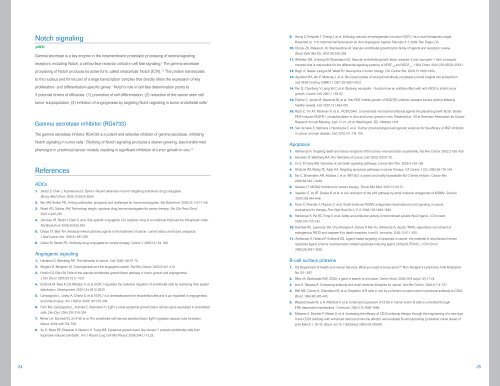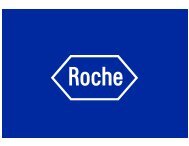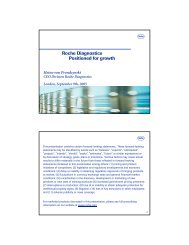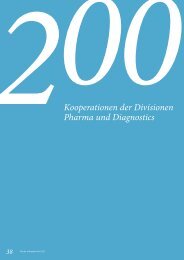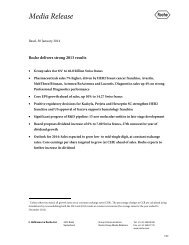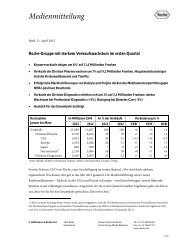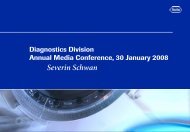Transforming the future of cancer treatment Oncology ... - Roche
Transforming the future of cancer treatment Oncology ... - Roche
Transforming the future of cancer treatment Oncology ... - Roche
Create successful ePaper yourself
Turn your PDF publications into a flip-book with our unique Google optimized e-Paper software.
Notch signaling<br />
pRED<br />
Gamma secretase is a key enzyme in <strong>the</strong> intramembrane proteolytic processing <strong>of</strong> several signaling<br />
receptors, including Notch, a cell surface receptor critical in cell fate signaling. 1 The gamma secretase<br />
processing <strong>of</strong> Notch produces its active form, called intracellular Notch (ICN). 1,2 This protein translocates<br />
to <strong>the</strong> nucleus and forms part <strong>of</strong> a large transcription complex that directly alters <strong>the</strong> expression <strong>of</strong> key<br />
proliferation- and differentiation-specific genes. 1 Notch’s role in cell fate determination points to<br />
3 potential drivers <strong>of</strong> efficacies: (1) promotion <strong>of</strong> cell differentiation, (2) reduction <strong>of</strong> <strong>the</strong> <strong>cancer</strong> stem cell<br />
tumor subpopulation, (3) inhibition <strong>of</strong> angiogenesis by targeting Notch signaling in tumor endo<strong>the</strong>lial cells. 1<br />
Gamma secretase inhibitor (RG4733)<br />
The gamma secretase inhibitor RG4733 is a potent and selective inhibitor <strong>of</strong> gamma secretase, inhibiting<br />
Notch signaling in tumor cells. 1 Blocking <strong>of</strong> Notch signaling produces a slower-growing, less-transformed<br />
phenotype in preclinical <strong>cancer</strong> models, resulting in significant inhibition <strong>of</strong> tumor growth in vivo. 1,2<br />
References<br />
ADCs<br />
1. Jaracz S, Chen J, Kuznetsova LV, Ojima I. Recent advances in tumor-targeting anti<strong>cancer</strong> drug conjugates.<br />
Bioorg Med Chem. 2005;13:5043-5054.<br />
2. Wu AM, Senter PD. Arming antibodies: prospects and challenges for immunoconjugates. Nat Biotechnol. 2005;23:1137-1146.<br />
3. Ricart AD, Tolcher AW. Technology insight: cytotoxic drug immunoconjugates for <strong>cancer</strong> <strong>the</strong>rapy. Nat Clin Pract Oncol.<br />
2007;4:245-255.<br />
4. Junutula JR, Raab H, Clark S, et al. Site-specific conjugation <strong>of</strong> a cytotoxic drug to an antibody improves <strong>the</strong> <strong>the</strong>rapeutic index.<br />
Nat Biotechnol. 2008;26:925-932.<br />
5. Ghose TT, Blair AH. Antibody-linked cytotoxic agents in <strong>the</strong> <strong>treatment</strong> <strong>of</strong> <strong>cancer</strong>: current status and <strong>future</strong> prospects.<br />
J Natl Cancer Inst. 1978;61:657-676.<br />
6. Carter PJ, Senter PD. Antibody-drug conjugates for <strong>cancer</strong> <strong>the</strong>rapy. Cancer J. 2008;14:154-169.<br />
Angiogenic signaling<br />
1. Hanahan D, Weinberg RA. The hallmarks <strong>of</strong> <strong>cancer</strong>. Cell. 2000;100:57-70.<br />
2. Bergers G, Benjamin LE. Tumorigenesis and <strong>the</strong> angiogenic switch. Nat Rev Cancer. 2003;3:401-410.<br />
3. Hicklin DJ, Ellis LM. Role <strong>of</strong> <strong>the</strong> vascular endo<strong>the</strong>lial growth factor pathway in tumor growth and angiogenesis.<br />
J Clin Oncol. 2005;23:1011-1027.<br />
4. Schmidt M, Paes K, De Mazière A, et al. EGFL7 regulates <strong>the</strong> collective migration <strong>of</strong> endo<strong>the</strong>lial cells by restricting <strong>the</strong>ir spatial<br />
distribution. Development. 2007;134:2913-2923.<br />
5. Campagnolo L, Leahy A, Chitnis S, et al. EGFL7 is a chemoattractant for endo<strong>the</strong>lial cells and is up-regulated in angiogenesis<br />
and arterial injury. Am J Pathol. 2005;167:275-284.<br />
6. Fitch MJ, Campagnolo L, Kuhnert F, Stuhlmann H. Egfl7, a novel epidermal growth factor domain gene expressed in endo<strong>the</strong>lial<br />
cells. Dev Dyn. 2004;230:316-324.<br />
7. Parker LH, Schmidt M, Jin S-W, et al. The endo<strong>the</strong>lial-cell-derived secreted factor Egfl7 regulates vascular tube formation.<br />
Nature. 2004;428:754-758.<br />
8. Xu D, Perez RE, Ekekezie II, Navarro A, Truog WE. Epidermal growth factor-like domain 7 protects endo<strong>the</strong>lial cells from<br />
hyperoxia-induced cell death. Am J Physiol Lung Cell Mol Physiol. 2008;294:L17-L23.<br />
9. Yeung S, Smyczek T, Cheng J, et al. Inhibiting vascular morphogenesis in tumors: EGFL7 as a novel <strong>the</strong>rapeutic target.<br />
Presented at: 11th International Symposium on Anti-Angiogenic Agents; February 5-7, 2009; San Diego, CA.<br />
10. Otrock ZK, Makarem JA, Shamseddine AI. Vascular endo<strong>the</strong>lial growth factor family <strong>of</strong> ligands and receptors: review.<br />
Blood Cells Mol Dis. 2007;38:258-268.<br />
11. Whitaker GB, Limberg BJ, Rosenbaum SJ. Vascular endo<strong>the</strong>lial growth factor receptor-2 and neuropilin-1 form a receptor<br />
complex that is responsible for <strong>the</strong> differential signaling potency <strong>of</strong> VEGF 165<br />
and VEGF 121<br />
. J Biol Chem. 2001;276:25520-25531.<br />
12. Bagri A, Tessier-Lavigne M, Watts RJ. Neuropilins in tumor biology. Clin Cancer Res. 2009;15:1860-1864.<br />
13. Appleton BA, Wu P, Maloney J, et al. Structural studies <strong>of</strong> neuropilin/antibody complexes provide insights into semaphorin<br />
and VEGF binding. EMBO J. 2007;26:4902-4912.<br />
14. Pan Q, Chan<strong>the</strong>ry Y, Liang W-C, et al. Blocking neuropilin-1 function has an additive effect with anti-VEGF to inhibit tumor<br />
growth. Cancer Cell. 2007;11:53-67.<br />
15. Fischer C, Jonckx B, Mazzone M, et al. Anti-PlGF inhibits growth <strong>of</strong> VEGF(R)-inhibitor-resistant tumors without affecting<br />
healthy vessels. Cell. 2007;131:463-475.<br />
16. Rizzo C, Yin XY, Packman K, et al. RO5323441, a humanized monoclonal antibody against <strong>the</strong> placenta growth factor, blocks<br />
PlGF-induced VEGFR-1 phosphorylation in vitro and tumor growth in vivo. Presented at: 101st American Association for Cancer<br />
Research Annual Meeting; April 17-21, 2010; Washington, DC. Abstract 1370.<br />
17. Van de Veire S, Stalmans I, Heindryckx F, et al. Fur<strong>the</strong>r pharmacological and genetic evidence for <strong>the</strong> efficacy <strong>of</strong> PlGF inhibition<br />
in <strong>cancer</strong> and eye disease. Cell. 2010;141:178-190.<br />
Apoptosis<br />
1. Ashkenazi A. Targeting death and decoy receptors <strong>of</strong> <strong>the</strong> tumour-necrosis factor superfamily. Nat Rev Cancer. 2002;2:420-430.<br />
2. Hanahan D, Weinberg RA. The hallmarks <strong>of</strong> <strong>cancer</strong>. Cell. 2000;100:57-70.<br />
3. Jin Z, El-Deiry WS. Overview <strong>of</strong> cell death signaling pathways. Cancer Biol Ther. 2005;4:139-163.<br />
4. Ghobrial IM, Witzig TE, Adjei AA. Targeting apoptosis pathways in <strong>cancer</strong> <strong>the</strong>rapy. CA Cancer J Clin. 2005;55:178-194.<br />
5. Tse C, Shoemaker AR, Adickes J, et al. ABT-263: a potent and orally bioavailable Bcl-2 family inhibitor. Cancer Res.<br />
2008;68:3421-3428.<br />
6. Vassilev LT. MDM2 inhibitors for <strong>cancer</strong> <strong>the</strong>rapy. Trends Mol Med. 2007;13:23-31.<br />
7. Vassilev LT, Vu BT, Graves B, et al. In vivo activation <strong>of</strong> <strong>the</strong> p53 pathway by small-molecule antagonists <strong>of</strong> MDM2. Science.<br />
2004;303:844-848.<br />
8. Tovar C, Rosinski J, Filipovic Z, et al. Small-molecule MDM2 antagonists reveal aberrant p53 signaling in <strong>cancer</strong>:<br />
implications for <strong>the</strong>rapy. Proc Natl Acad Sci U S A. 2006;103:1888-1893.<br />
9. Ashkenazi A, Pai RC, Fong S, et al. Safety and antitumor activity <strong>of</strong> recombinant soluble Apo2 ligand. J Clin Invest.<br />
1999;104:155-162.<br />
10. Kischkel RC, Lawrence DA, Chuntharapai A, Schow P, Kim KJ, Ashkenazi A. Apo2L/TRAIL-dependent recruitment <strong>of</strong><br />
endogenous FADD and caspase-8 to death receptors 4 and 5. Immunity. 2000;12:611-620.<br />
11. Ashkenazi A, Holland P, Eckhardt SG. Ligand-based targeting <strong>of</strong> apoptosis in <strong>cancer</strong>: <strong>the</strong> potential <strong>of</strong> recombinant human<br />
apoptosis ligand 2/tumor necrosis factor-related apoptosis-inducing ligand (rhApo2L/TRAIL). J Clin Oncol.<br />
2008;26:3621-3630.<br />
B-cell surface proteins<br />
1. US Department <strong>of</strong> Health and Human Services. What you need to know about TM Non-Hodgkin’s Lymphoma. NIH Publication<br />
No. 05-1567.<br />
2. Riley JK, Sliwkowski MX. CD20: a gene in search <strong>of</strong> a function. Semin Oncol. 2000;27(6 suppl 12):17-24.<br />
3. Imai K, Takaoka A. Comparing antibody and small-molecule <strong>the</strong>rapies for <strong>cancer</strong>. Nat Rev Cancer. 2006;6:714-727.<br />
4. Reff ME, Carner K, Chambers KS, et al. Depletion <strong>of</strong> B cells in vivo by a chimeric mouse human monoclonal antibody to CD20.<br />
Blood. 1994;83:435-445.<br />
5. Wojciechowski W, Li H, Marshall S, et al. Enhanced expression <strong>of</strong> CD20 in human tumor B cells is controlled through<br />
ERK-dependent mechanisms. J Immunol. 2005;174:7859-7868.<br />
6. Mössner E, Brünker P, Moser S, et al. Increasing <strong>the</strong> efficacy <strong>of</strong> CD20 antibody <strong>the</strong>rapy through <strong>the</strong> engineering <strong>of</strong> a new type<br />
II anti-CD20 antibody with enhanced direct and immune effector cell-mediated B-cell cytotoxicity [published online ahead <strong>of</strong><br />
print March 1, 2010]. Blood. doi:10.1182/blood-2009-06-225979.<br />
24<br />
25


